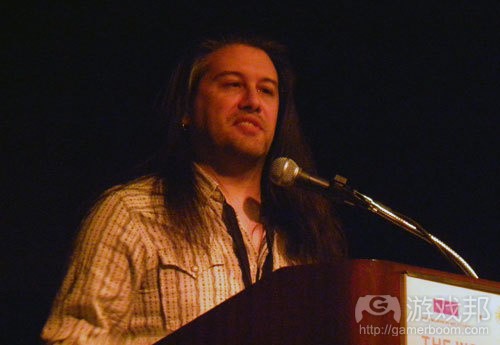Inside Social Games:游戏设计本身就是一种游戏
游戏邦注:本文作者是Brenda Brathwaite,她在游戏开发方面拥有20多年的经验,其经典作品包括《Jagged Alliance》和《Wizardry》系列。
Facebook最精彩的游戏也是创收最丰厚,节奏紧凑的游戏,即游戏本身的设计。对于身处这个该行业,特别是那些来自传统游戏领域的开发人士而言,游戏设计已经自成游戏,也有排行榜。
电子游戏元老设计师John Romero(游戏邦注:其为游戏《Ravenwood Fair》的首席设计师和咨询顾问)表示,“每天半夜,我都会浏览AppData。”这个网站其实已经成为许多开发商的排行榜,主要通过每周热门游戏名单来体现。
怀着对游戏设置深厚的感情,许多设计师把社交游戏设计及其引发的设计师之间的竞争当作即时策略游戏,游戏包含深刻数据以及由编码员、美工、动画师和产品经理组成的队伍。的确,我们应对当前游戏状态(包括真实Facebook游戏和大型游戏的设计)的能力至关重要。
另一位游戏设计元老Don Daglow则以将领视角看待这些数据。他表示,“社交游戏设计很特别,因为你每天都能获得各方面表现状况的反馈。就像高速运转的SEO。最近辅助功能调整之后,有多少初次玩家重返游戏?游戏DAU如何?调整价位之后,营收有何变化?测试员是否喜欢新元素?所有商业活动都是游戏,但社交游戏业务到处都设有24小时排行榜。”
就像我们回应游戏中的玩家活动一样,游戏设计师也需要回应游戏设计中的其他成员。如果某个玩家取得突破,创造十分巧妙的策略或引入新机制、新主题,其他玩家可以通过亲自试验、观察ARPU(游戏邦注:每用户平均收益)或研究竞争对手做出相应回应。游戏大量繁殖(如农场、烹饪和经营旅游胜地游戏)就是最好例子。
我在旧金山游戏开发者大会演讲时,把游戏设计视作游戏的观点忽然闪现在我的脑海中,当时在场的同伴包括Playdom游戏设计副总裁史帝分·马瑞察克、Zynga首席设计师布赖恩·雷诺兹以及The Inspiracy总裁Noah Falstein。我们是以电子游戏元老进军社交游戏领域的身份参与大会讨论。当大家纷纷落座后,我们就开始讲述那些几十年来老生常谈的话题,但也有新鲜元素,那就是我们所处的新游戏状态。
布赖恩无疑是Zynga目前的首领,其用户数量不断增加。当我们谈到目前制作的作品、数据以及大概的未来规划时,我们的谈话瞬间变成硬核桌面游戏开发者谈论自身当前状态,以及如何步步为营。我们四个人经常一起玩桌面游戏,因此所做对比更加浅显和有趣。我最后表示,“游戏设计就是游戏。”这个言论随后出现在微博当中,大家纷纷转载。
Falstein表示,“我某种程度上把自己的设计工作当作同其他设计师比较社会地位。我希望优化他们的游戏功能,同时添加我自己的创新,从而能够在下个桌面游戏聚会上赢得地位积分,以及帮助顾客和自己赢得RMT回馈,”Meretzky甚至还打趣地提到背后的资源管理。“我请求同事给予资源。通常要求4、5次之后,我就能完成某个任务!”大量即时反馈信息通常能让置身传统AAA掌机游戏多年转投社交游戏领域的开发者颇感兴奋。
3 Blokes Studios创意总监John Passfield表示,“好游戏通常具有定期反馈循环机制,社交游戏设计显然具备该机制。传统游戏开发工作主侧重背后的游戏创建,就像训练奥运会运动员一样。然而社交游戏开发者的开发工作则主要是通过听取产品经历意见调整游戏,留心其他团队及粉丝反馈。开发者直接投入开发当中,而不需要提前热身。”
每个作品都可以有延伸版本,都可以进行调整,都有望获得DAU的增长。雷诺兹将认为自己的游戏就是如此,他表示,“每周我都能从游戏功能设置中获得回馈,并且添加更多新功能,然后我们到处收集各种数据!”
从游戏设计师的角度看,能够成为游戏设计“玩家”是个有趣而令人兴奋的事情。体验空间完全开放(游戏邦注:就像体验时间仅几分钟的《Civilization Revolution》),这个领域还有供挖掘的空间,还有许多东西有待探索。这些游戏都是小团队基于特殊主题瞄准新玩家制作的,游戏行业观察者表示,从很多方面看,游戏行业好像又回到1981年。现在态势很好,我们会记得1983年,北美电子游戏崩溃的那年,我们已经能够相应调整策略。(本文为游戏邦/gamerboom.com编译,如需转载请联系:游戏邦)
Game Design Has Become a Game
[Editor's note: Brenda Brathwaite is a game designer with over 20 years of experience and credits on classic titles like Jagged Alliance and the Wizardry series. She is currently creative director at social game developer LOLapps.]
The most exclusive game on Facebook is also the most lucrative and intense: the game design of the games themselves. For designers in the space, particularly those from the traditional game industry, game design has become its own game, complete with a leaderboard.
“Every night at midnight, I check AppData,” says John Romero, a veteran video game designer, consultant and lead designer of Ravenwood Fair. The site has become a de facto leaderboard for many developers, backed up by weekly top games lists.
Imbued by a deep love of game play, many designers view social game design, and the competition it creates with other designers, as a real-time strategy game, complete with in-depth stats and armies composed of coders, artists, animators and product managers. Indeed, our ability to respond to the current state of the game — both the actual game on Facebook and the larger meta game of game design — is critical.
Don Daglow, another veteran game designer, watches the numbers like a general. “Social game design is unique,” he says, “because you get a score for every facet of your performance every day. It’s like SEO on speed. How many first-time players came back the next day after the latest tutorial tweaks? What’s our DAU? How is monetization changing since we adjusted item prices? Did the test players like the new gorilla suit costume? All of business is a game, but the social games business has 24-hour scoreboards on every corner.”
As much as we respond to the player behavior in our games, game designers also must respond to the other “players” in the meta game of design, too. If one player makes a move, invents a particularly clever tactic or introduces a new mechanic or theme, the other “players” respond accordingly by trying out the move themselves, watching their ARPU or doing recon behind enemy lines. The mass proliferation of games about farming, cooking, and running resorts serve as perfect examples.
The idea of game design as a game in itself first occurred to me in an active, front-of-the-brain kind of way when I was on stage at this year’s Game Developer’s Conference in San Francisco with fellow game designers Steve Meretzky, VP of game design at Playdom, Brian Reynolds, chief game designer at Zynga, and Noah Falstein, president of The Inspiracy. We were there to talk as video game veterans who had entered the social game space. As the room began to fill, we talked of the things we’ve talked of for the decades we’ve known one another, but there was something else there, too: a new gamestate between us.
Brian was the obvious current leader at Zynga, and every day, his numbers just kept rising. As we talked of the games we were working on, our numbers and, in a veiled way, our future plans, it quickly became apparent that our conversation had all the earmarks of hardcore board game players yapping about their current gamestate while keeping their next move carefully guarded. That we four actually do regularly play board games together made the comparison all the more obvious, amusing and interesting. “Finally, game design is a game,” I said to the audience. It was promptly tweeted and retweeted dozens of times.
Says Falstein, “I look at my design job partly as a social status issue with my fellow designers. I want to improve the best of their games’ features while adding my own innovations, thereby earning status points at our next board game party, as well as earning RMT equivalents for my client – and therefore, me too.” Meretzky even jokingly alluded to the resource management that happens behind closed doors. “I beg my co-workers for resources. After asking four or five times, I often have everything I need to complete a task!” The rush and instant feedback is particularly exciting for game designers entering the space after years in the traditional AAA console game industry.
“Good games have regular feedback loops and social game development has these in spades,” says John Passfield, creative director at 3 Blokes Studios. “The majority of time in traditional game development is spent building a game behind closed doors which is more like training for the Olympics. Whereas social game development puts you smack in the middle of a full season where you’re constantly adjusting your game by listening to your coach (product manager), watching the other team and playing to the fans. It’s about being in the moment, not preparing for the moment.”
That moment, that hour and that day, each allows for iteration and tweaking of the meta-game state and a hopeful resultant climb in DAU. Quick to compare it to his own game, Reynolds said, “Every week I harvest my features and plant some more, and then we run around collecting all the doobers!”
From a game designer’s perspective, it is a wonderful, exciting time to be a “player” in the game of game design. The play space feels wide open, like a game of Civilization Revolution only a few minutes in, with lots of room to explore and many things to discover. Games are being made with small teams about unique topics for new audiences, and in many ways, say the game industry vets, it feels like 1981 again. It is good, too, that we remember 1983, the year of the North American video game crash, and can adjust our strategy accordingly.(Source:Inside Social Games)
上一篇:解析如何推出备受关注的免费游戏
下一篇:解析游戏设计如何影响虚拟商品交易









































 闽公网安备35020302001549号
闽公网安备35020302001549号